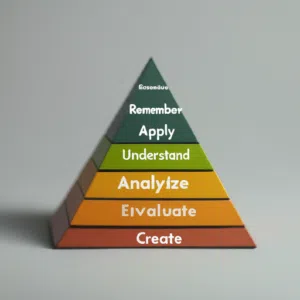Introduction to Bloom’s Taxonomy
What is Bloom’s Taxonomy?
Bloom’s taxonomy is one of the most effective framework that is designed to guide the trainers to create a framework to categorizer different kinds of learning into a simple one. Benjamin Bloom, one of the renowned educational psychologist created this framework in 1956 along with a group of corroborators. It was designed keeping the goal in mind that it will help the educators or trainers to design effective learning framework and assessments. In this comprehensive guide, we will explore the in-depth analysis of Bloom’s taxonomy. We will also explore why this is important, what are the different phases and how it can be utilized in corporate training. Let’s get started.

Why Should Corporate Trainers Care About Bloom’s Taxonomy?
To understand it better, Bloom’s taxonomy is a tool that helps the educators and trainers to plan their lessons in such a way that results in deeper understanding of the topic among the learners. It also incorporates long term retention and ensures that the retention can be evaluated with proven methods of assessments as well. It not only provides a clarity and direction to the learning methodologies but also develop a high value thinking capacity in the learners. Here is why every corporate trainers should know about Bloom’s taxonomy.
- 1. Defines Learning Objective: It helps in defining the learning objectives clearly and thus helps your learners to achieve the objectives quicker and more effectively.
- 2. Better Assessments: It also helps in creating assessments that can evaluate the learning of each of the learners better.
- 3. Improves Lesson Plan: It improves your lesson plans 10 folds as with Bloom’s taxonomy you can plan every single things inside that classroom.
By applying Bloom’s taxonomy you can ensure that your learners are not memorizing the topic, rather they are understanding it and applying it to their day to day job.
Historical Context and Evolution
When originally created in the year 1956, the Bloom’s taxonomy had 6 different levels namely Knowledge, Comprehension, Application, Analysis, Synthesis, and Evaluation. However, in 2001, one of the former students of Bloom mentioned that it needs to be in sync with the cognitive process and along with a few collogues, he renamed the levels as Remember, Understand, Apply, Analyze, Evaluate, and Create. These new levels of Bloom’s taxonomy not only aligns the learning of the training to the organizational goals but also provides challenges to the learners to think critically and apply the design thinking methods to resolve the problems in hand.
The Relevance of Bloom’s Taxonomy Today
Today is the time when everything is so fast paced. Corporate wants the ground level workers to be trained within a short period of time and effectively. It is important for the trainers to plan the lesson well to reduce the wastage of time. The well planned lesson can not only provide effective retention but ensures that necessary action items are taken care off. Bloom’s taxonomy does just that for you and that is the reason it is important to know about it. Using this framework, you can create a value for your trainees and include that fun element so that the sessions are engaging, helps the learners think critically and most importantly apply all that knowledge practically.
6 Levels of Bloom’s Taxonomy
Let’s dive deep into each levels of Bloom’s taxonomy and understand what they are, how they apply to the corporate training and why they are important in corporate training.
Level 1: Remember

Remember: This is the basic foundation of the Bloom’s taxonomy. All other levels are build on this and it is known as the foundation of the Bloom’s Taxonomy. This means to recall or memorizing something during the training session.
For example, this level can be utilized for the following scenarios:
- 1. Memorizing the steps for a standard operating process for a particular topic
- 2. Recalling the different tabs on a particular tool and their functionalities
- 3. Listing down the names of different KRA elements that one should following while doing their job
As a trainer/ facilitator, it is important to ensure that you follow this steps to ensure that the trainees remember the content. It is also to ensure that the trainees have the basic knowledge to handle the job requirements. While creating lesson plan, you should keep in mind that what are the items that a trainee need to remember at the end of the session. This could be as simple as the KRA or the complex SOP of creating a fund for the customers in some highly complex technical tool.
Activities that you can use in this level includes but not limited to are quizzes, flashcards or a simple “Did You Know” activity. You can use the verbs that align with the Bloom’s taxonomy while creating the quizzes or activities such as : Define, List, Remember or Recall. A summary after each of the sessions goes a long way to ensure that the learners remember the pointers covered during the session. So don’t forget to summarize after each of the topic or even sub-topics.
It is also important to provide constructive feedback during this level. The learners may deviate or make mistakes while recalling the items covered during the session. It is important to correct them with a positive and optimistic way by sharing a quick feedback. As a trainer it is your responsibility to ensure that the learners progress from one level to another.
Level 2: Understand

Understand: It means grasping or meaning something in someone’s own way. I can easily remember the names of the tabs of a complex tool but it won’t stay long inside my brain unless I understand the functionality of the tab and relate to something in my daily life. You will consider that the learners understood about a particular topic when they are able to explain it on their own words.
This level of Bloom’s taxonomy incorporates that the learners know the why behind a task that they are performing. For example, explaining why certain safety protocol such as verifying the customer is important. This is also in accordance with the adult learning principle as the adults needs to know why they are doing something that they are doing.
Other application of this level would be interpreting the customer feedback to improve performance or summarizing the key points of a company policy and why it is important to follow such protocols. If you are a technical trainer (meaning if you are explaining a tool or system to your learners), this is more important. They need to be able to relate their understanding to something in the real life.
This level mostly deal with explaining ideas or concepts to your learners. You can either facilitate group discussions or use concept maps to deepen the understanding. You can also create a group amongst your learner and ask them to facilitate a particular topic to check the level of their understanding. It is said that you learn anything better when you target to teach. Verbs that you can use in this level are summarize, describe, explain or present.
Level 3 – Apply
Apply: As the name suggests, this level of Bloom’s Taxonomy involves in applying learning to a new and concrete scenario. This is where theory meets practical. For an example, lets assume that you are training your learners about a technical tool and how to use it. In the previous two steps, you have informed them about the basic tabs and navigation (Remember) and functionalities of each tabs (Understand).

Now it is time for the trainees to navigate through different tabs on their own on situation based simulations. If the tool contain customer data base, you can simply ask your learners to find the phone number of a particular customer.
You can also use this level to provide hands on practice to your learners about training them on various other concepts. Such as conflict resolution techniques in a team meeting, applying sales technique to various scenarios or even handling a difficult customer.
You can also use this level of Bloom’s taxonomy to solve a math problem using a specific formula or creating a sentence using a particular subject verb agreement rule etc. Verbs that are commonly used in this level are use, solve, demonstrate, implement, apply, operate etc.
Activities that you can use in this level could be related to demonstrating a certain behavior or concept. You can create pairs amongst your learners and ask them to show a demo about the topic that you have covered. You can also use scenario based problems and ask individuals to solve them by creative thinking.
Level 4: Analyze
Analyze: In this level of Bloom’s taxonomy, the learner should break down the information into simpler and smaller parts to understand how they relate to each other and overall structure. At this level, the learners should dissect the information into different parts to identify patterns and understand the logic behind the concepts. This is where the problem solving skills and critical thinking blooms out.

For example, you can use this level to analyze the various sales data to understand the pattern of the customer behavior. Breaking down a project into different parts to make the learners understand how their roles relates to overall project. Or you can even use this to analyze the customer complains to understand the root cause of the issue. You can use methodologies like 5 why technique, PDCA etc.
You can use activities like group discussions, mock brainstorming sessions and creating fishbone diagram in this level. My favorite activity in this level is by creating flashcards containing questions and answers, mix the card, shuffle them and then distribute 2 of them to each of your learners. Now if they have two questions, they will need to find the answers and if they have answers they will need to find the question. They will need to negotiate with each other to get the other pair of the flashcard.
In this level, encourage learners to compare, contrast, or break down a concept into parts. Verbs that you can use in this level of Bloom’s taxonomy are differentiate, compare, organize etc.
Level 5: Evaluate
Evaluate: In this level of Bloom’s taxonomy learner should be able to assess the value of any information, process or methods and make informative judgement based on their understanding. In this level, you should encourage your learners to develop their evaluative skill and provide constructive feedback about the judgements that they are making.

For example, based on the customer’s requirements and lifestyle which product would be the best fit for them or based on the certain criteria if the customer is eligible for a discount or a refund.
Another few example of this level could be assessing the performance of a marketing material, evaluating team’s performance against the defined goal etc.
In this level, you can use activities like debates, case studies, or performance reviews to develop critical thinking. Verbs that can be use to conduct activities in this level should be critique, justify or argue etc.
It is significant that at this level you are sharing continuous constructive feedback to your learners. They are all new to this and if facilitated properly this could be a lot of fun as well.
Level 6: Create
Create: In this level of Bloom’s taxonomy, the learner should utilize all of the learning from the previous levels to put together a plan or a complete function to complete a assigned task. It’s about generating new ideas, products, or ways of doing things. This level is all about creativity and innovation and the trainer should drive this culture rigorously. This is also called as the pinnacle of Bloom’s taxonomy.

For example, creating a new script to handle difficult customers based on the previous customer experience or feedback, or designing a new training method to onboard the new joiners. It could also be about creating a complete new product or process based on the current market trends and customer feedback.
In this level, the trainer should inspire the learners about innovation as “Can you think of a new way to do this?” or ” How would you improve your score?”. It could also be about creating new ideas that can improve the existing process or products.
The activities that you can use in this level could be more related to creating a new thing. Create separate groups within the learners and ask them to think of a new idea to handle a specific scenario and then present it to the entire class. They can also propose a new solution that can improve any existing process or product. Verbs that you can use in this level are design, construct, formulate etc.
Each level of Bloom’s Taxonomy corresponds to specific types of learning objectives. By aligning training goals with these levels, trainers can create more targeted and effective learning outcomes.
Now let’s take a look at an example of real life situation with the all the levels together. Assume that you are conducting a leadership training and your goal is to create a resource pool for team leads with better leadership and decision making skills. In the level one of Bloom’s taxonomy, the learners will memorize a few leadership theories, move on to understanding those theories in level 2 and applying them on hypothetical situations on level 3. In level 4, they will then analyze the outcome of applying those theories and evaluate their effectiveness in level 5. Finally on level 6, they will be able to create their own leadership approach.
Tips for Using Bloom’s Taxonomy in Your Training
To ensure you’re getting the most out of Bloom’s Taxonomy in your training programs, here are some practical tips and strategies:
1. Crafting Questions and Tasks Aligned with Each Level
- Remembering: Use questions like “What are the key components of…?” or “Can you list the steps in…?”
- Understanding: Ask, “How would you explain…?” or “Can you summarize the process of…?”
- Applying: Pose tasks such as “Demonstrate how you would use…” or “Show how you can apply this method to…”
- Analyzing: Encourage deeper thinking with “What are the differences between…?” or “Can you break down the elements of…?”
- Evaluating: Challenge employees with “How would you assess the effectiveness of…?” or “What criteria would you use to evaluate…?”
- Creating: Inspire innovation with “Can you design a new way to…?” or “How would you improve…?”

2. Encouraging Deeper Thinking and Creativity
To move beyond surface-level learning, encourage employees to question assumptions, explore alternatives, and think critically about the information presented. Create opportunities for them to engage in discussions, debates, and problem-solving activities that challenge them to use higher-order thinking skills.
3. Incorporating a Variety of Learning Activities
Design your training sessions to include a mix of activities that cater to different levels of Bloom’s Taxonomy. For example:
- Role-playing: Helps with applying knowledge in simulated real-world scenarios.
- Case studies: Allow for analyzing and evaluating complex situations.
- Group projects: Foster collaboration and creativity, leading to the creation of new ideas or solutions.
4. Tailoring Training to Your Audience
Not all employees will start at the same level of understanding, so it’s essential to tailor your training programs to meet the diverse needs of your audience. Use pre-assessment tools to gauge their current knowledge and skills, then design your training to fill in gaps and build on existing strengths.
Final thoughts about Bloom’s Taxonomy
Bloom’s Taxonomy offers a powerful framework for structuring corporate training programs. By progressing through the six levels—Remembering, Understanding, Applying, Analyzing, Evaluating, and Creating—trainers can ensure that employees not only acquire essential knowledge but also develop the skills needed to apply that knowledge in real-world settings and innovate within their roles.
The beauty of Bloom’s Taxonomy is its flexibility. Whether you’re designing a leadership development program, onboarding new hires, or providing ongoing professional development, Bloom’s Taxonomy can guide the process to ensure that learning is both effective and meaningful. Ultimately, by using this framework, you’ll empower your employees to not only succeed in their current roles but also to grow, adapt, and thrive in the ever-changing corporate landscape.

![The Power of Storytelling in Corporate Training: Igniting Success and Inspiring Growth [2023]](https://trainercentric.com/wp-content/uploads/2023/06/storytelling-1024x576.jpg)

